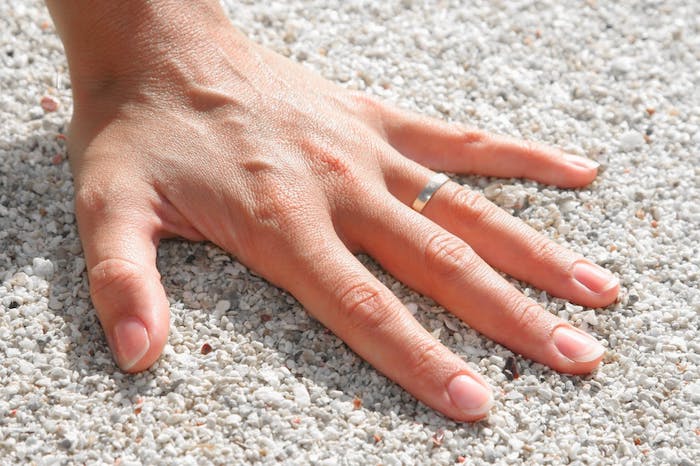Dry, Peeled Cuticles: Why It’s Important to Take Care of Them Now!

Dry, peeling cuticles don’t look great, and sometimes they can hurt and bleed, but that’s not a big deal, right?
That’s usually true, but in some cases, dry and peeling cuticles can indicate an underlying health problem.
In this post we explain why caring for your cuticles is so important, not only for aesthetic reasons, but also for health reasons.
Dry, peeling cuticles: why it’s important to care for them
Well-groomed cuticles make your nails look more beautiful, creating a polished and healthy appearance. Neglected cuticles, on the other hand, not only look dry and ragged, but can also lead to an uneven nail bed, even if your nails are perfectly manicured.
Dry and loose cuticles can also damage your nails. Here’s how:
Infection risk
When cuticles are dry and loose, they can create openings for bacteria and fungi, leading to infections that can affect the nail bed and overall nail health. This is especially true for your hands, which are exposed to many germs every day. If you walk around barefoot, dry and loose cuticles on your toes can also lead to infections.
Weak nail structure
Healthy cuticles can protect the nail where new growth occurs, but damaged cuticles compromise the protective barrier, potentially leading to weaker nails that split or break more easily.
Hangnails
You know how these feel. Ouch! Dry cuticles often lead to hangnails, which are painful and can lead to inflammation and infections around the nail.
Problems with nail growth
Poorly maintained cuticles can disrupt the natural growth of the nails, leading to irregular shapes and uneven surfaces.
Pain and discomfort
Inflammation and irritation from dry cuticles can make it uncomfortable to use your hands, making everyday tasks painful.
Dry and peeling cuticles: a health warning?
In some cases, dry and peeling cuticles can be a sign that something else is going on with your health. Here are some possibilities.
Dehydration
If you don’t drink enough water throughout the day, your cuticles can dry out and start to peel. Even mild dehydration can start the process.
Nutritional deficiencies
A lack of some essential vitamins and minerals, especially biotin, vitamin E and zinc, can affect the health of nails and cuticles. If you regularly care for your cuticles, but they are still dry and peeling, it may be a good idea to see a doctor.
Health conditions
Skin conditions such as eczema and psoriasis can cause the cuticles to dry out and peel more quickly than normal. Other health conditions such as thyroid problems and autoimmune diseases can also have dry and peeling cuticles as a symptom.
Dry and peeling cuticles: what are their causes?
Besides the above-mentioned problems that can cause dry and peeling cuticles, they are usually caused by the following:
Dehydration
As mentioned above, if you don’t drink enough water during the day to hydrate the skin and cuticles from within, they can be drying.
Environmental factors
Exposure to harsh weather conditions, such as cold air, wind, or low humidity, can strip moisture from the skin and cuticles.
Wash hands regularly
Regular washing with soap and water or hand sanitizer can remove moisture from the skin. Without bringing that moisture back, you can end up with dry cuticles.
Aggressive chemicals
Prolonged contact with cleaning products, detergents and some nail care products can irritate and dry out the cuticles.
Nutritional deficiencies
As mentioned above, a deficiency in certain essential nutrients, including vitamins A, C and E, biotin and omega-3 fatty acids, can affect skin and nail health.
Skin conditions
Conditions such as eczema, psoriasis and fungal infections can affect the health of the cuticles and cause dryness and peeling.
Nail biting or picking
These habits can damage the cuticles and lead to inflammation or infection.
Hormonal changes
Fluctuations in hormones, especially during pregnancy or menopause, can affect the moisture content of the skin.

Dry and peeling cuticles: how to prevent and treat them
Taking the time to care for your cuticles not only makes them look and feel better, it also helps promote a strong nail matrix, which in turn supports healthy nail growth. Soft, intact cuticles minimize the chance of cracking around the nails, reducing the risk of infection. They are also less likely to cause painful hangnails.
Ultimately, taking care of your cuticles will maintain the overall health of your hands, reducing problems such as cracking or dermatitis. Follow these tips to keep your cuticles looking and feeling their best.
1. Hydrate regularly
Drink water throughout the day for overall skin hydration. Aim for at least eight glasses a day to keep your skin soft and resilient from within.
2. Moisturize your cuticles
This is a step we often miss when caring for our hands. We moisturize our hands, but we don’t focus on the cuticles. Regular hand cream may not penetrate deep enough to nourish the cuticles in particular. Using a special product on the cuticles can only provide more concentrated moisture and nutrients.
Try our dermatologist-recommended, multi-tasking Repairing Skin Balm to prevent dry cuticles and soften them if they’re already dry. The balm serves as a protective barrier and helps prevent bacteria from entering the nail base while calming inflammation. It helps retain moisture and is packed with nourishing and healing ingredients. Apply it to the cuticles morning and evening to keep them soft and supple.
3. Avoid harsh chemicals
Limit exposure to harsh soaps, detergents and nail products that can strip the skin of its natural oils. Use gloves when cleaning or washing dishes to protect your hands, and always apply our Restorative Skin Balm after a manicure to help repair your cuticles. You can feel good knowing that this balm is 100% free of harmful ingredients.
4. Maintain good nail hygiene
Trim and clean your cuticles regularly, but don’t cut them too deeply as this can lead to bleeding and infection. Soak your hands in warm water and gently push back the cuticles with a cuticle stick. Cut away excess material.
Tip: You can also apply a little Restorative Skin Balm to soften the cuticles, making them easier to push back.
5. Exfoliate
Just as you regularly exfoliate your face, gently exfoliating your hands and cuticles can help remove dead skin cells and prevent dryness. Use a sugar scrub or soft brush to keep the cuticles smooth.
6. Eat a balanced diet
Consume foods rich in biotin (like eggs and nuts), vitamin E (like avocados and seeds), and omega-3 fatty acids (found in fish and flaxseed) to nourish your skin from within.
7. Limit hot showers and baths
Hot water feels great, but it quickly strips your skin of moisture. Usually choose lukewarm water and try to limit long soaks.
8. Consider using a humidifier
If you live in a dry climate, having a humidifier in your room can help add moisture to the air, reducing the chance of waking up with dry skin and cuticles.
9. Try a DIY Cuticle Soak
If your cuticles need extra care, try creating a soothing bath with warm water mixed with a few drops of olive oil and a tablespoon of honey. Soak your fingertips (or toes) for about 10-15 minutes. This treatment helps hydrate and soften the cuticles, while the honey provides antibacterial properties. After soaking, gently push back the cuticles and apply Restorative Skin Balm for extra moisture and production.
10. Perform overnight treatment
To speed up the recovery of dry, peeling cuticles, you can apply olive oil or coconut oil directly to them. Leave this on for 1-2 minutes and then apply our Restorative Skin Balm. Put on soft cotton gloves (or socks), then go to bed and let your cuticles heal overnight. You’ll be happy to wake up with softer, healthier cuticles, hands and feet.
Do you suffer from dry, peeling cuticles?
Featured image by Tristan Perrier via Pexels.





